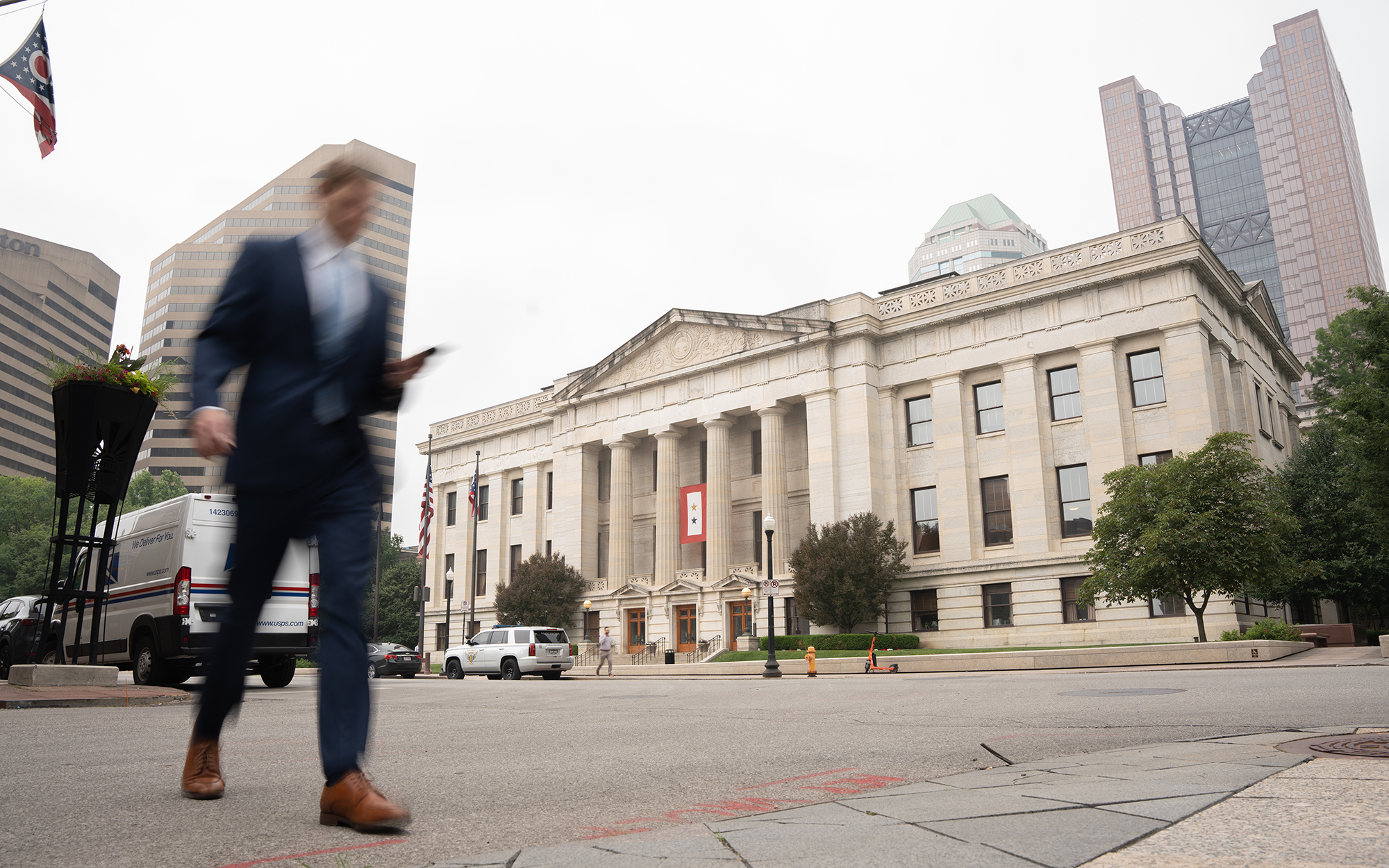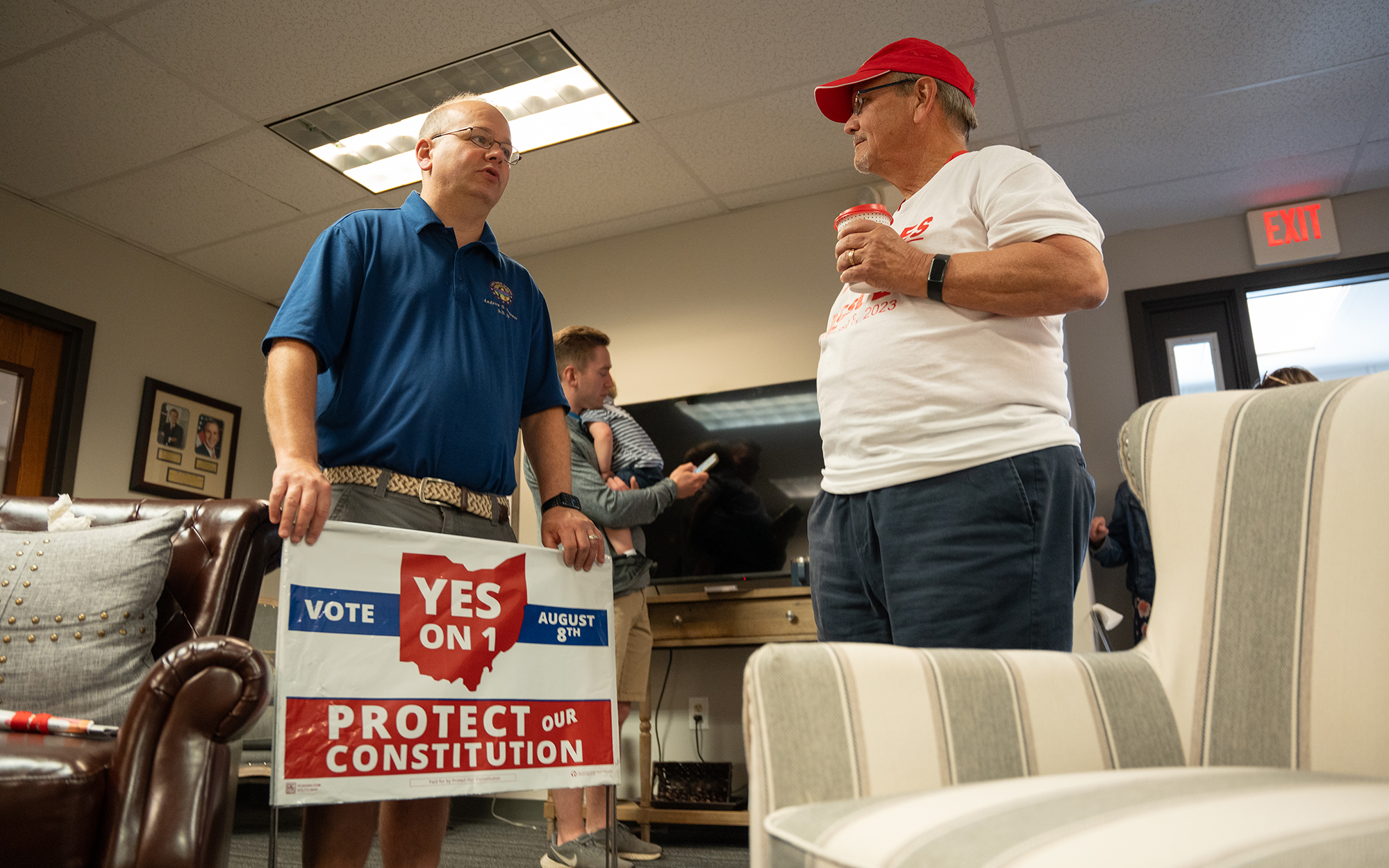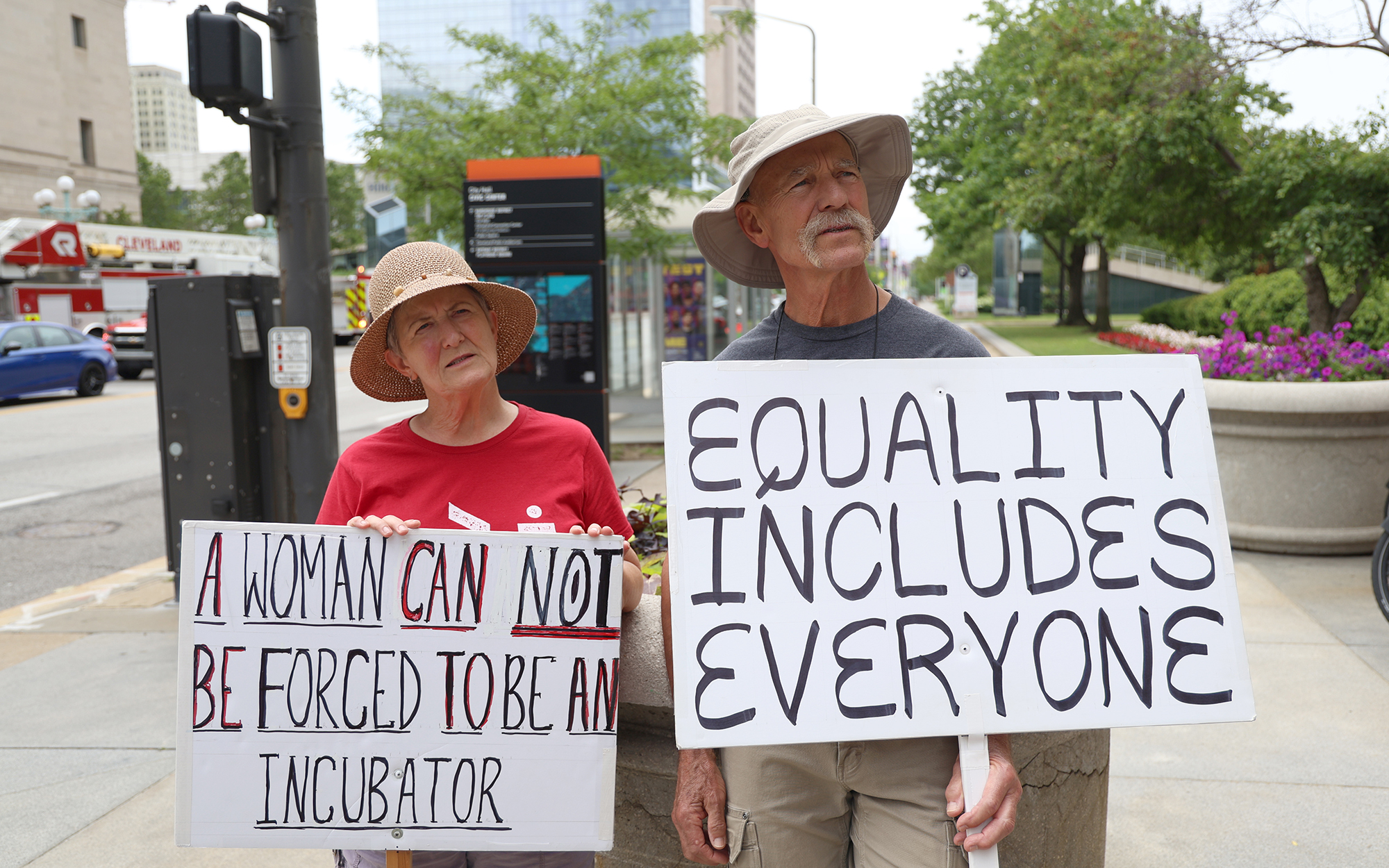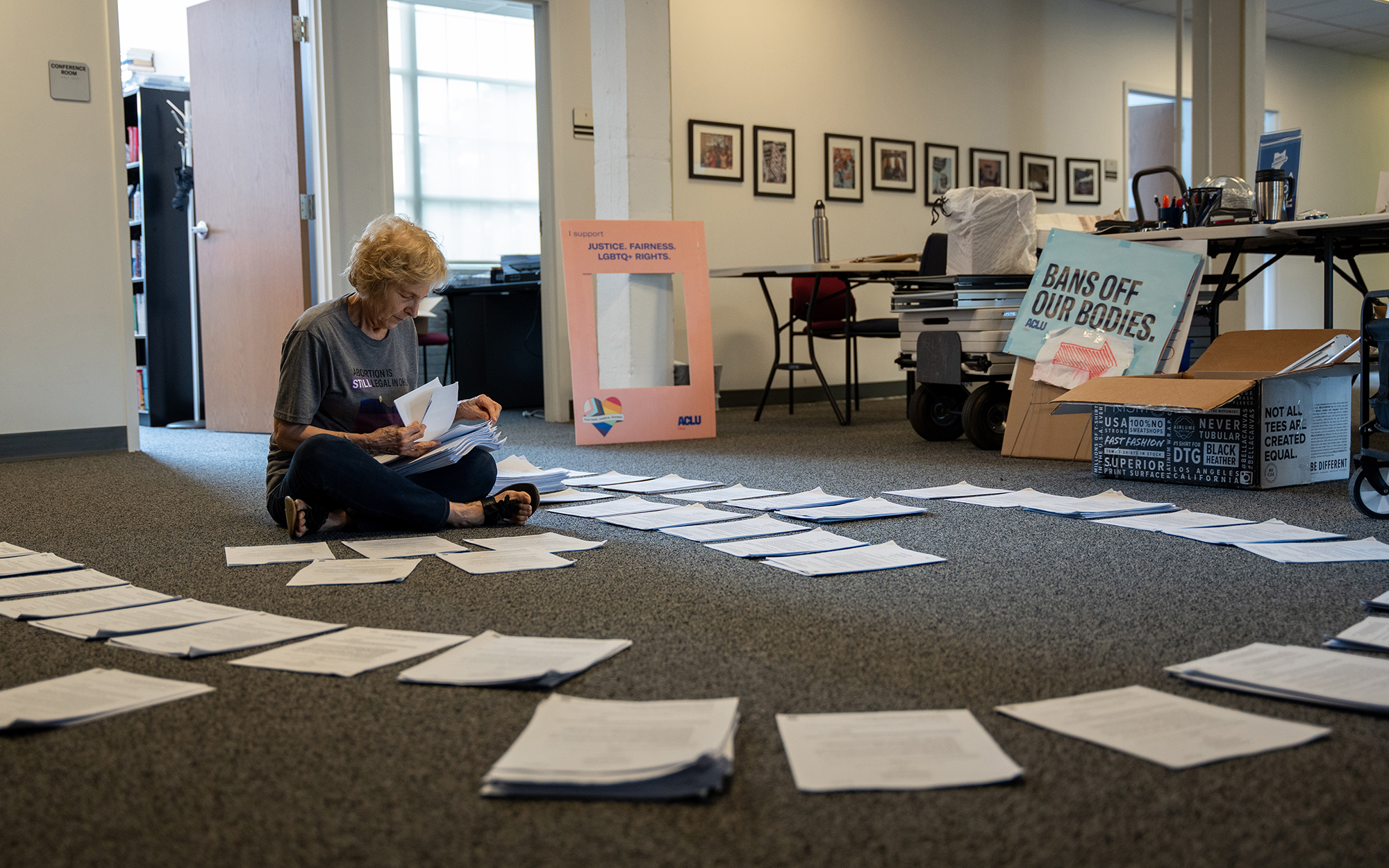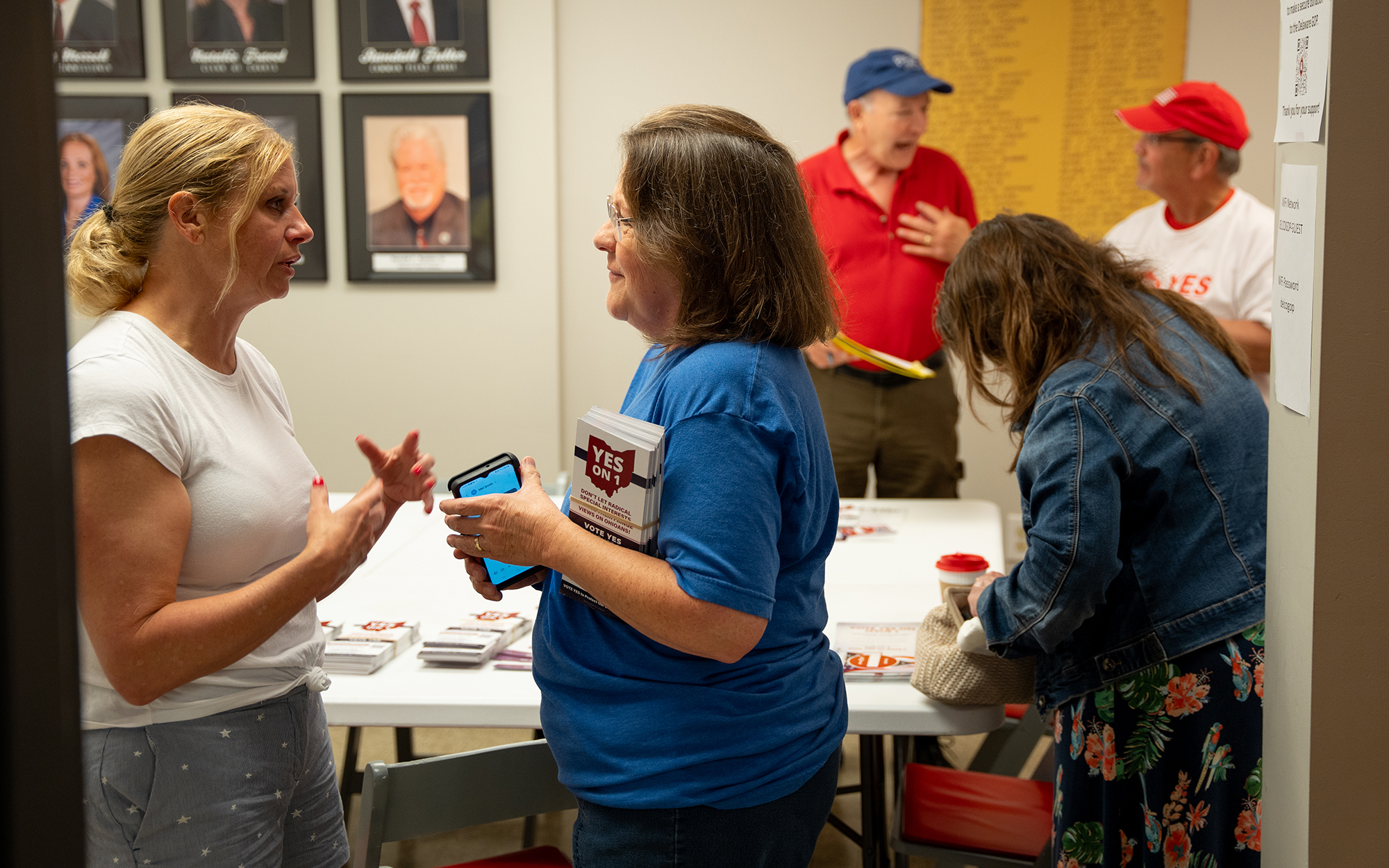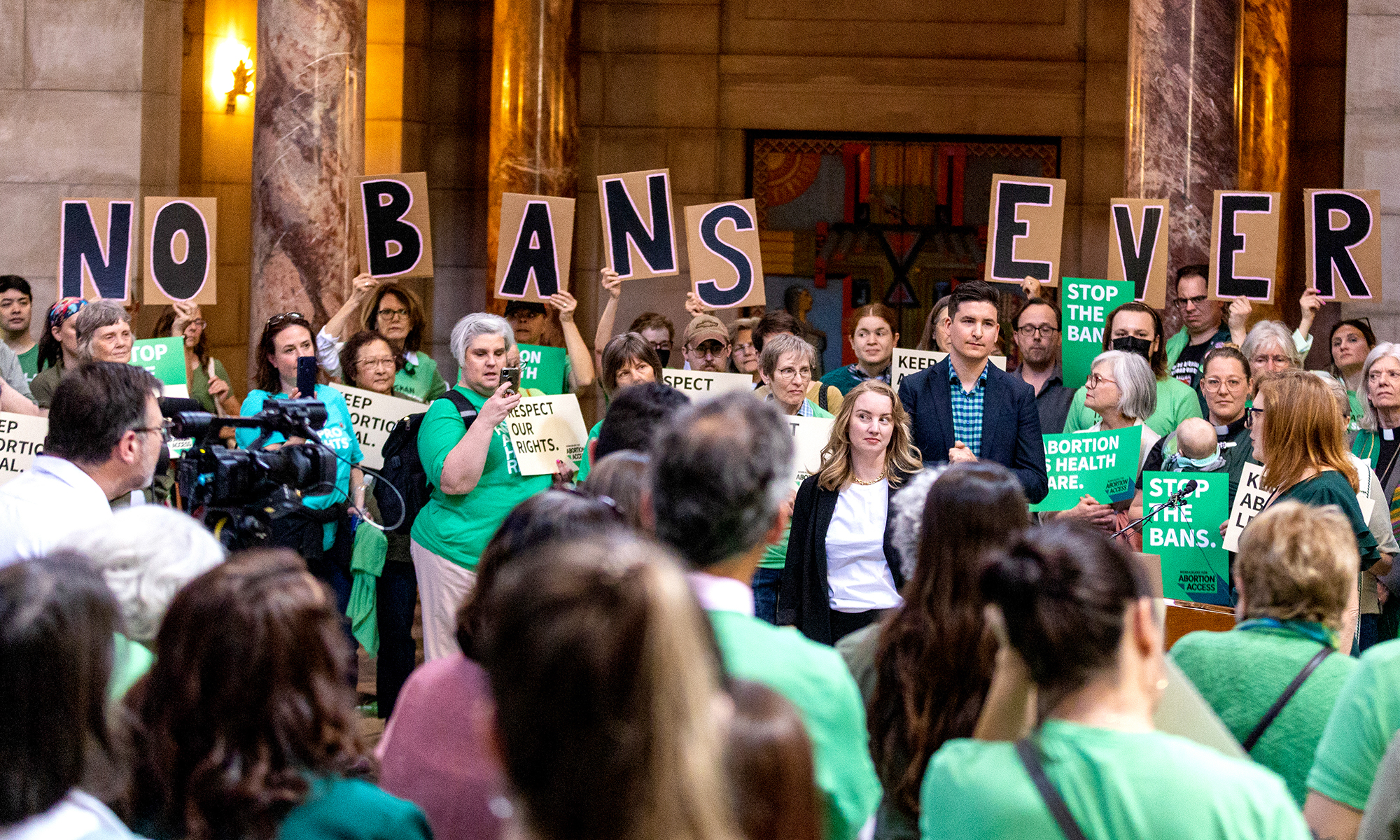
(Video by Mingson Lau/News21)
Ohio special election, proposed constitutional amendment illustrate broader battles on abortion
A year after the reversal of Roe v. Wade, activists are facing off at the ballot box. In Ohio, voters are deciding whether to make it harder to amend the state constitution. That election comes just months before they consider an amendment to protect abortion rights.
Our content is free to use with appropriate credit. See the terms.
DELAWARE, Ohio – About two dozen people crammed into a room at the local Republican Party headquarters. An “End Corruption, Vote Trump” poster hung on the wall behind a folding table displaying State Issue 1 pamphlets next to a stack of anti-abortion flyers.
They gathered this June day to celebrate the first anniversary of the fall of Roe v. Wade and the undoing of federal protections for abortion rights – but also to galvanize for the next phase of their fight.
For Ohio Republicans, that means an August special election that could, for the first time in 111 years, change how voters approve amendments regarding issues “not addressed properly (or at all) in the Ohio Constitution.”
“I can breathe a sigh of relief knowing that our babies here in Ohio are being protected,” said Janine Baker, president of the Delaware City Republican Club, who later in the day went door-to-door canvassing for State Issue 1.
Baker called the reversal of Roe “a huge accomplishment.”
“But also,” she said, “we still have work to do.”

Ohio Secretary of State Frank LaRose speaks at the GOP headquarters in Delaware, Ohio, on June 24, 2023, the one-year anniversary of the reversal of Roe v. Wade. Republicans gathered to celebrate the decision and gear up for a special election to potentially raise the threshold to amend the state constitution. (Photo by Mingson Lau/News21)
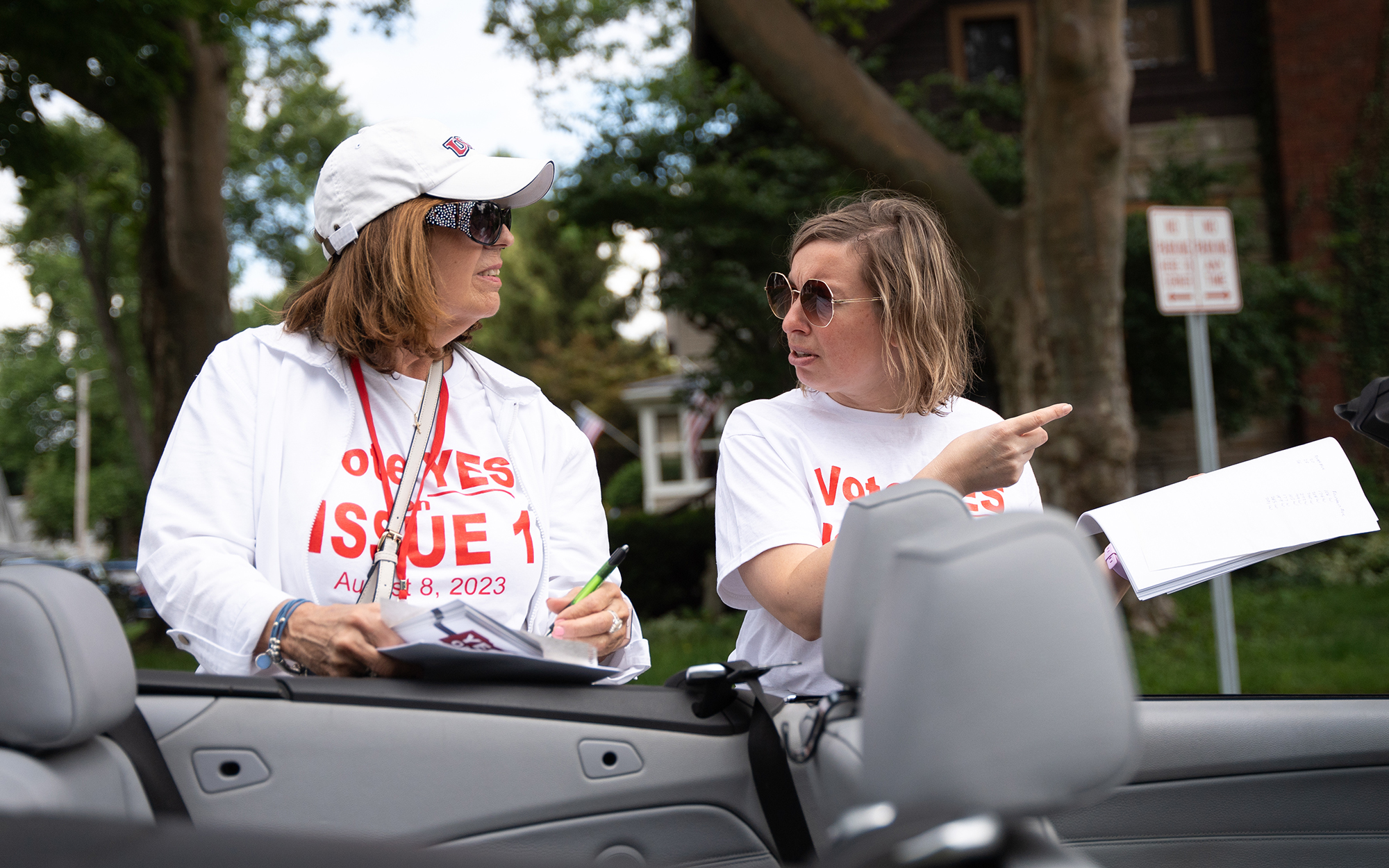
Kristine Wolfe, left, a Delaware County precinct committeewoman, and Janine Baker, president of the Delaware City Republican Club, plan their route as they go door to door on June 24, 2023, to urge people to vote “yes” on State Issue 1. (Photo by Mingson Lau/News21)
If State Issue 1 passes on Aug. 8, any proposed amendment to the state constitution would require 60% voter approval, rather than the current simple majority of 50% plus one vote.
In an editorial urging Ohioans to oppose the measure, The Columbus Dispatch called the proposal “one of the most significant questions Ohio voters will be asked in generations.”
“It speaks to Ohio’s heart and whether or not undemocratic forces will be successful in corrupting it with very big lies,” the newspaper said.
The political maneuvering in this state is just one example of how Americans across the political spectrum are mobilizing post-Roe, engaging in battles at the ballot box that could affect far more than abortion – and, potentially, influence the outcome of the 2024 presidential race.
“It’s a bit of a test case,” said Alice Clapman, senior counsel in the voting rights program at the Brennan Center for Justice, a nonpartisan policy organization housed at New York University.
“Whether lawmakers are able to sneak through this really major change to a system that’s been in place for over a century will speak to how well our democratic norms are holding up nationally, will speak to what activists and lawmakers are trying to do in other states.”
‘This is our freedom’
State Issue 1 has a direct connection to the fight over abortion rights in Ohio.
In May, the GOP-controlled Legislature passed a resolution approving the Aug. 8 special election. The move came soon after Republican lawmakers had eliminated most August special elections, calling them unnecessary and expensive.
“It’s more than one issue. It’s more than one election. This is about our ability as everyday Ohioans to pass policies that improve our daily lives. This is our freedom that we must protect.”
— Jen Miller
Executive Director, League of Women Voters of Ohio
What caused the reversal?
On Nov. 7, Ohio voters are set to decide whether to enshrine abortion rights in the state constitution, joining other states working to protect abortion access. If State Issue 1 passes, far more votes will be needed to approve the so-called Right to Reproductive Freedom amendment in November.
Jen Miller, executive director of the League of Women Voters of Ohio, called the August election an obvious attempt to block the abortion amendment.
“It’s absolutely no coincidence,” she said. “But it’s beyond that. It’s more than one issue. It’s more than one election. This is about our ability as everyday Ohioans to pass policies that improve our daily lives. This is our freedom that we must protect.”
The face-off over these competing measures began after last summer’s U.S. Supreme Court ruling in Dobbs v. Jackson Women’s Health Organization, which overturned Roe and returned regulation of abortion to the states.
Amy Burkett, an OB-GYN in Akron, was working a 24-hour shift when a text message alerted her to the decision that rolled back nearly five decades of legal precedent.
“I was like: Oh my God, they took everything.”
Hours later, a law banning abortion at six weeks took effect, leaving Ohioans with very limited access.
“At four o’clock on a Friday afternoon, we went from having abortion as a right with some restrictions …(to) the six-week ban,” Burkett said. “It was much faster than we initially anticipated.
“We had no time to think about what it meant … and what we needed to plan for.”
Soon after, a group of doctors launched Ohio Physicians for Reproductive Justice and signed on to a letter demanding repeal of the state’s abortion ban. They asked lawmakers to “defend the separation of church and state, to support reproductive autonomy, and to respect our basic rights to life, liberty, and the pursuit of happiness.”
That effort expanded into a push to gather the 400,000-some required signatures to get a measure to protect abortion on the state ballot.
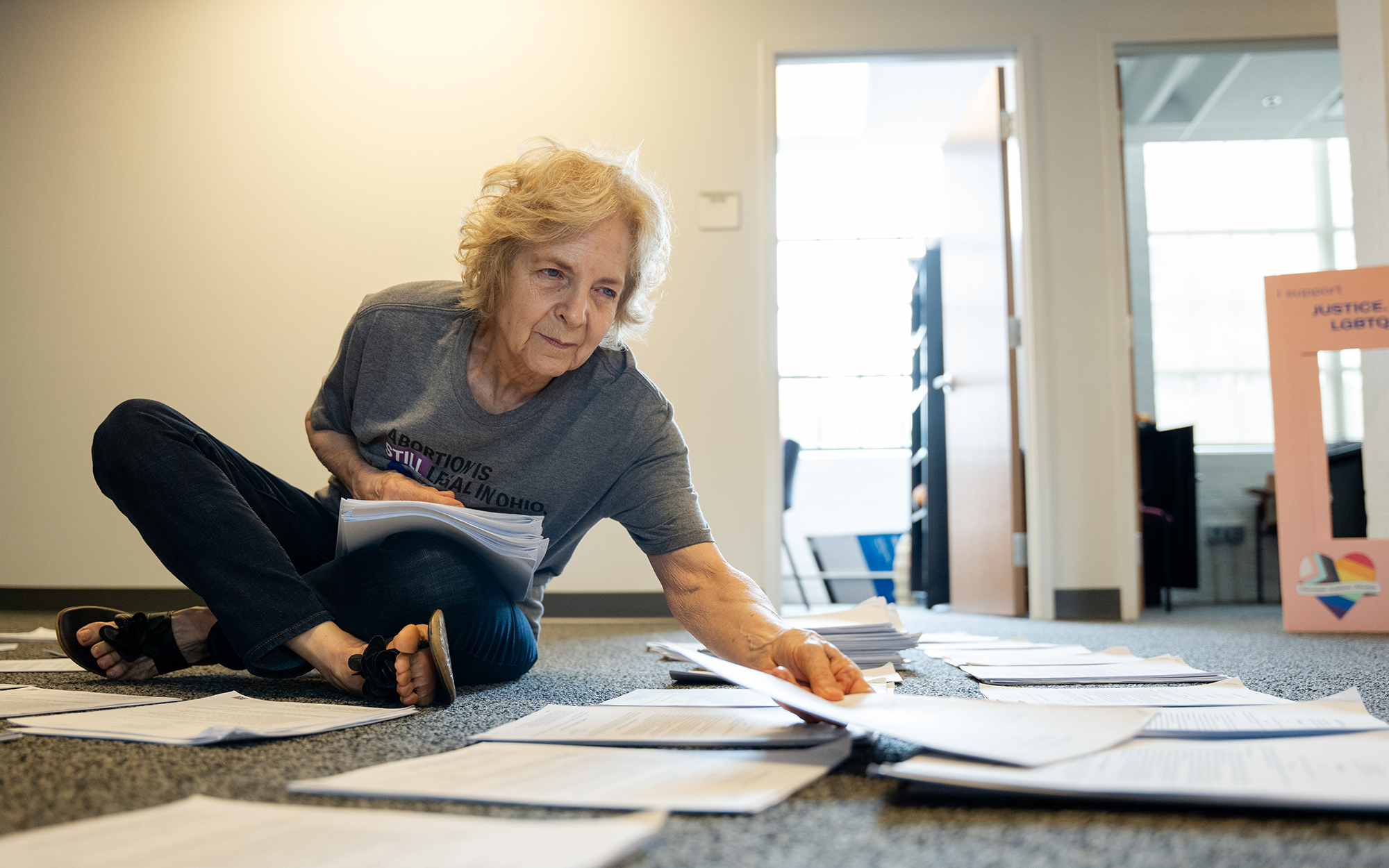
Bobbie Ackerman organizes petitions at the American Civil Liberties Union of Ohio office in Columbus on June 26, 2023. The group helped lead the push to get a constitutional amendment to protect abortion rights on the November ballot. (Photo by Mingson Lau/News21)

Asia Ven sorts petitions on June 26, 2023, at the American Civil Liberties Union of Ohio office in Columbus. (Photo by Mingson Lau/News21)
“Now we’re trying to amend the Ohio Constitution,” Burkett said, “which is certainly not what I thought I was going to be doing as an OB-GYN – ever.”
The proposed amendment would guarantee every individual the right to make and carry out their own reproductive decisions, including but not limited to decisions on contraception, fertility treatment, miscarriage care and elective abortion.
For now, the state’s six-week ban is on hold amid court challenges, and abortion remains available through 22 weeks of pregnancy.
With State Issue 1 looming, abortion-rights advocates are working to encourage citizens to vote “no” in August and “yes” in November. Anti-abortion activists are pushing for the exact opposite.
The stakes are high, said Alice Hirsh, development officer for the American Civil Liberties Union of Ohio.
“Issue 1 has a huge impact on not just the reproductive rights ballot initiative in November, but it’ll have a huge impact on every other citizen-initiated ballot initiative that Ohioans want to put forward,” Hirsh said.
Supporters of State Issue 1 insist constitutional amendments should require a supermajority to pass.
Amy Natoce, a spokeswoman for the anti-abortion group Protect Women Ohio, called the measure a “common sense protection” against “out-of-state special interests … who think they can fly into Ohio with their unlimited war chests and circumvent our Legislature to buy their way into the constitution.”
Natoce cited national groups, including the ACLU and Planned Parenthood. ACLU of Ohio and Planned Parenthood Advocates of Ohio are among those fighting for the November abortion amendment.
Issue 1, meantime, has received support from Richard Uihlein, a conservative billionaire from Illinois. According to The Columbus Dispatch, Uihlein gave about $1.1 million to a political action committee that pushed ads urging lawmakers to support Issue 1.
The inconsistency between the words and actions of supporters of Issue 1 has been noted by their opponents. David Pepper, former chair of the Ohio Democratic Party, characterized the Republican messaging as disinformation.
“All of it is to fool voters into doing something which voters never normally do,” he said, “take power away from themselves and give it to politicians.”
A national trend
Some states have tried for years to make it harder to pass constitutional amendments. Post-Roe, efforts have been renewed as anti-abortion advocates look for ways to counter proposed measures to protect abortion rights.
In Missouri this year, legislators offered at least 18 joint resolutions to modify the citizen initiative process. A separate proposal aimed to eliminate any constitutional protections to abortion. None made it through the Legislature.
In Arkansas, the governor signed a measure requiring signatures from 50 counties, instead of 15, for an initiative to qualify for the ballot.
In North Dakota, lawmakers approved a proposal to increase the number of signatures required to put an amendment on the ballot. That measure will go before voters in 2024.
Florida, Idaho and Oklahoma also put forth measures attempting to increase requirements for the initiative process.
“Ohio’s just the first example of a few places where legislators are nervous about using ballots to change state constitutions to protect reproductive rights,” said Rachel Rebouché, dean of Temple University’s Beasley School of Law and an expert in reproductive health law. “So their solution is just to change how ballot measures operate.
“I think that we can expect to see a lot more of this in the future.”
In Florida – always a major player in presidential politics – abortion rights advocates are mobilizing to put an amendment to protect abortion on the ballot in 2024. In 2006, the state increased the threshold for passage of constitutional amendments to 60%.
The League of Women Voters of Florida has come out in support of the proposed amendment. Cecile Scoon, one of the group’s leaders, believes it will eventually pass because, she said, the heart of the debate runs deeper than party allegiance.
“People don’t want the government in their intimate lives making these kinds of choices for them,” Scoon said. “Americans, we love our freedom, right? We don’t want anybody telling us what to do. If that is presented to the citizens, I’m really prayerful and hopeful, and we’ll work really hard to make sure we get to that threshold.”
Ballot initiatives are an important measure of how people feel on something specific like abortion, because they “decouple” issues from party politics, Rebouché said.
“So it’s not being thrown in with electing your congressperson or your state representative,” she said. “When people go to just talk about abortion, they’re not as against it as maybe the people they’ve elected.”
That was made clear in November, when voters in Kansas and Kentucky, where Republicans control the legislatures, rejected constitutional amendments that would have denied individuals the right to abortion.
“Ohio’s just the first example of a few places where legislators are nervous about using ballots … to protect reproductive rights. So their solution is just to change how ballot measures operate.”
— Rachel Rebouché
Dean of Temple University’s Beasley School of Law
Citizen-led initiatives arose during the national progressive movement of the late 19th and early 20th centuries. Proponents of progressivism wanted to limit political corruption and the influence of corporations in politics while promoting measures to improve working and living conditions in a rapidly changing world.
Most states that feature a form of direct democracy, like ballot initiatives or referendums, introduced that process during the progressive era. Among them are California, Washington, Oklahoma, Utah, South Dakota, Arkansas and Massachusetts. Ohio’s process was approved after a Constitutional Convention in 1912.
Despite challenges to the process, initiatives remain popular with citizens, and the threshold to approve a citizen constitutional amendment in most states is still a simple majority.
“Ohio has been, since 1912, a shining example of direct democracy where Ohio voters can pass policies when politicians fail us,” said Miller, of the state’s League of Women Voters. “That’s the example we should be for the country. And that’s why Ohioans need to show up and vote ‘no’ in droves, so that no other state gets this idea.”
A fight for every vote
On the weekend of the first anniversary of the reversal of Roe, volunteers on both sides of the abortion debate hit the ground in Ohio with one common goal: Get people to the ballot box.
At a community festival in Columbus, a volunteer working on behalf of the abortion amendment shouted over the thrum of music to ask passersby the same question again and again: “Anybody want to sign the petition to legalize abortion?”

Amber Holman, right, signs a petition for the proposed “Right to Reproductive Freedom” amendment at a community festival in Columbus on June 25, 2023. In November, Ohio voters will decide whether to enshrine abortion rights in the state constitution. (Photo by Maddy Keyes/News21)
With just a few hours left at the festival, volunteers in pink shirts with “Vote for Reproductive Rights” across the back wove through the crowd with clipboards and pens. It was the final push to collect signatures to put the “Reproductive Freedom” amendment on the Nov. 7 ballot.
Gabriel Mann, communications manager for Pro-Choice Ohio, led a presentation for festival-goers about the amendment and its importance.
“There has been a full decade of different bans and restrictions that have been passed by politicians here in Ohio, and none of them have the patient’s interests at heart,” he said in an interview.
“We need to pass this policy.”
About 30 miles north, in the city of Delaware, volunteers wearing red and white “Vote Yes” T-shirts had their speeches ready as they went door to door to advocate for passage of State Issue 1.
“We’re out wanting to save our Ohio Constitution,” Kristine Wolfe, a Delaware County precinct committeewoman, told one voter on her canvassing trail.
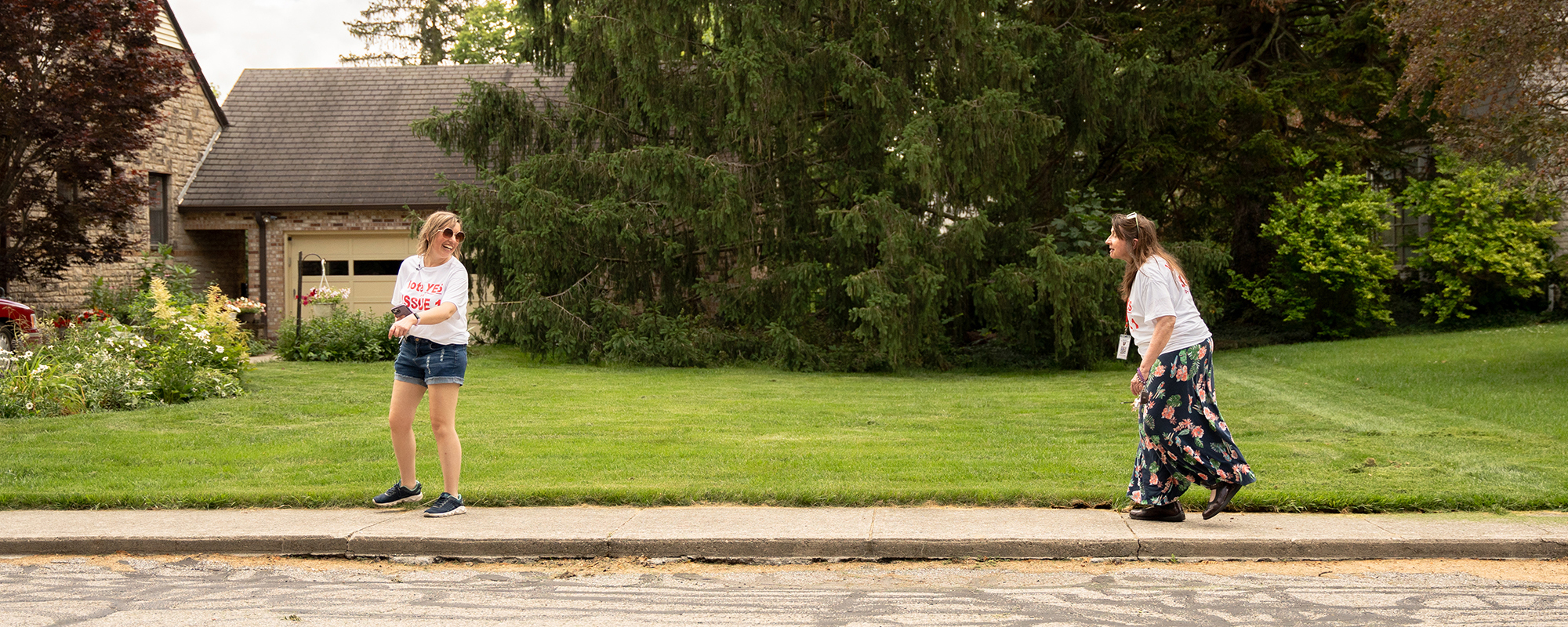
Janine Baker, left, president of the Delaware City Republican Club, and Maureen Studer go door to door in Delaware, Ohio, on June 24, 2023, to urge voters to approve State Issue 1. (Photo by Mingson Lau/News21)
For more than two hours on a sunny afternoon, volunteers walked past freshly mown lawns and jangling wind chimes, knocking on doors and placing pamphlets under bricks or tucking them inside screen doors.
Wolfe said it was her passion for protecting human life and an old saying that kept her going:
“If you don’t wear out the soles of your shoes during a campaign cycle, you’re not working hard enough.”
News21 reporter Mingson Lau contributed to this report.
Our content is free to use with appropriate credit. See the terms.
